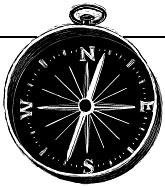Student Perspective
Helping in the outdoors
By Timothy Burdick (email)
One evening last August, pagers sounded across the region and members of the Upper Valley Wilderness Response Team (UVWRT) raced to their computers to check e-mail instructions from their team leader. We were to prepare for an early morning search for a small plane that had vanished from radar in central Vermont. There was a family of three aboard, plus the family dog. As I packed my gear, my mind replayed one of the search and rescue (SAR) stories told to me by my grandfather Allan Handy, who had been a resident at Hitchcock in the 1950s.

|
|
Illustration by Suzanne DeJohn My goal as a wilderness medical responder is to reduce pain and prevent death when people get into trouble in the outdoors. |
History: In 1959, two DHMC physicians, Ralph Miller and Robert Quinn, crashed their private plane in central New Hampshire's Pemigewasset Wilderness during a snow squall. Although 500 volunteers organized by the Dartmouth Outing Club searched for more than 10 weeks, the two weren't found till too late—the search had been focused in the wrong location. It was later discovered that they had survived the crash with minimal injuries and had used a bone saw and medical tape to fashion snowshoes. But though they lasted four days in the sub-zero weather, they were unable to hike out. Miller's final sentence in his journal reads, "Survival instinct fights pain." The incident galvanized the community and began a tradition of wilderness search and rescue at Dartmouth (recounted in David Hooke's Reaching That Peak: 75 years of the Dartmouth Outing Club).
My goal as a wilderness medical responder is to reduce pain and prevent death when people get into trouble in the outdoors. Unfortunately, I did not have that opportunity at the Vermont plane crash site—the impact had killed all aboard. The State Police asked me, as a medical student, to help place the remains into blue body bags. Although the process was similar to what I had done in the anatomy lab every day for a year, this situation was different. At the subsequent critical- incident stress debriefing, I shared my feelings with the other rescuers. Ironically, it was the dog's body that had triggered my emotions, because it made me realize that this had been a family.
Working in concert: When the UVWRT responds to a call, highly trained medics, cliff-rescue technicians, radio operators, and compass navigators work in concert, usually under adverse conditions, where lives—of rescuers as well as of victims—can be threatened. The UVWRT is a critical piece of the emergency medical system in New Hampshire and Vermont, since few others have the resources, skill, or experience to perform wilderness rescues.
The team maintains a busy training schedule to keep our skills fresh and to instruct new volunteers. Every other week, we hold an evening session at Kellogg Auditorium to teach advanced medical skills, map and compass use, radio maintenance and communications, and technical climbing skills. Once a month, we hold an all-day mock rescue in the mountains, often with other SAR teams. And each year, we teach or cosponsor classes for the team and the public: SAR basics, wilderness EMT training, and high-angle cliff rescues.
As medical officer, I teach skills not used by most Emergency Medical Technicians (EMTs): reducing dislocations, building splints from standard camping equipment, and clearing the cervical spine after a fall. Wilderness medicine principles differ from urban protocols because the backcountry EMT may be treating a patient not for minutes but for hours or even days. Failing to attempt a reduction of a dislocated shoulder in a patient who is two days from the trailhead could result in neurovascular damage so severe that the arm might have to be amputated. Wilderness medicine requires the medic to think, to improvise, and to treat without the safety net of a nearby trauma center. Even cell phones and helicopters are rarely available during rescues because of bad weather and rugged terrain. In 1994, the UVWRT helped to evacuate a woman who broke her ankle at 3:30 p.m. on New Hampshire's Franconia Ridge; she arrived at the hospital the next day at 7:30 p.m.—28 hours after the accident.
Community effort: Although the UVWRT is organized through the DMS Community Service Committee, and usually includes from two to five medical students, most team members are not associated with the Medical School. This year, Gillian Salton '01 and I are the only students. The team's executive officer is a general contractor in New London, N.H., and the team leader is a firefighter in Hanover. Team members must purchase their own personal equipment—boots, snowshoes, crampons, climbing harnesses, helmets, headlamps, rain gear, clothing, and backpacks. With donations from individuals and corporations, and grants from DMS and outside agencies, UVWRT purchases the team gear—first-aid supplies, litters (rigid baskets for carrying people), rescue ropes, radios, etc. We always need replacement equipment in order to operate effectively and safely.
I enjoy being outdoors, making use of my growing medical knowledge, and being part of a community of caring individuals who have become my friends. The UVWRT allows me to combine all of these passions while at the same time serving the outdoor communities of New Hampshire and Vermont.
Timothy Burdick, DC '89 and DMS '02, is currently the medical officer for the DMSstudent- run Upper Valley Wilderness Response Team. He also holds a master's degree in forest ecology, has taught secondary school science, and has been an outdoor and rafting guide. For more information about UVWRT, e-mail uvwrt@dartmouth.edu.
Back to Dartmouth Medicine Summer 2000
